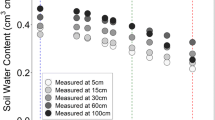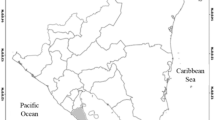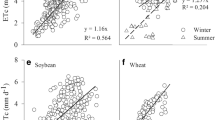Abstract
In some of the traditional areas growing sugarcane and in most of the expanding regions in Brazil, water deficit stress is a limiting factor and irrigation is usually needed to assure economically viable sugarcane yields. This research evaluated the water requirements of a drip-irrigated second ratoon sugarcane crop based on three different spatial scales: field, plant and leaf. The Bowen ratio method (BRM) was used to evaluate the mass and energy exchanges over the field, further computing the crop evapotranspiration (ETc). Sap flow by heat balance method installed in four representative stalks was used to evaluate the water use at the plant scale, and an infra-red gas analyser was used to evaluate leaf transpiration and stomatal conductance at the leaf scale. Comparing ETc and reference evapotranspiration we found that the crop coefficients for dry and wet seasons were 0.81 and 0.98, respectively. Evapotranspiration peaks of 7 mm day−1 were observed under conditions of strong crop-atmosphere coupling and high net radiation values. The stomatal conductance ranged from 0.09 to 0.19 mmol m−2 s−1 in dry and wet seasons respectively, showing sensitivity to the atmospheric conditions, notably the vapour deficit pressure and wind speed. BRM ranged from 3.7 to 4.4 mm day−1 and leaf transpiration ranged among 3.4 and 4.2 mm day−1. In an irrigated sugarcane production area in Brazil, water consumption of the sugarcane crop was highly correlated with atmospheric conditions.



Similar content being viewed by others
References
Allen, R.G., L.S. Pereira, D. Raes, and M. Smith 1998. Crop evapotranspiration: guidelines for computing crop water requirements. FAO 56, Irrigation and Drainage Paper 56: 297.
Chabot, R., S. Bouarfa, D. Zimmer, C. Chaumont, and S. Moreau. 2005. Evaluation of the sap flow determined with a heat balance method to measure. Agricultural Water Management 75: 10–24.
Inman-Bamber, N.G., and M.G. McGlinchey. 2003. Crop coefficients and water-use estimates for sugarcane based on long-term Bowen ratio energy balance measurements. Field Crops Research 83: 125–138.
Jarvis, P.G., and K.G. McNaughton. 1986. Stomatal control of transpiration: scaling up from leaf to region. Advances in Ecological Research 15: 49.
Marin, F.R., and L.R. Angelocci. 2011. Irrigation requirements and transpiration coupling to the atmosphere of a citrus orchard in Southern Brazil. Agricultural Water Management 98: 1091–1096.
Marin, F.R., L.R. Angelocci, M.A. Coelho Filho, and N.A. Villa Nova. 2001. Construction and evaluation of aspired thermocouple psychrometer. Scientia Agricola 58: 839–844.
Perez, P.J., F. Castellvi, M. Ibañez, and J.I. Rosell. 1999. Assessment of reliability of Bowen ratio method for partitioning fluxes. Agricultural and Forest Meteorology 97: 141–150.
Sakuratani, T. 1981. A heat balance method for measuring water sap flow in the stem of intact plant. Journal of Agricultural Meteorology 39: 9–17.
Sakuratani, T., and J. Abe. 1985. A heat balance method for measuring water sap flow in the stem of intact plants and its application to sugarcane plants. Japan Agricultural Research Quarterly 19: 92–97.
Silva, L.D.B., M.V. Folegatti, and N.A. Villa Nova. 2005. Evapotranspiration of guinea grass using automated Bowen ratio system and lysimeter. Engenharia Agrícola 25: 705–712.
Silva, T.G.F.S., S. Zolnier, M.S.B. Moura, J.F.A. Carmo, and A. Ribeiro. 2012. Decoupling factor in an irrigated sugarcane crop in the lower-middle São Francisco. Revista Brasileira de Engenharia Agrícola e Ambiental 16: 849–858.
Zeggaf, A.T., S. Takeuchi, H. Dehghanisanij, H. Anyoji, and T. Yano. 2008. A Bowen ratio technique for partitioning energy fluxes between maize transpiration and soil surface evaporation. Agronomy Journal 100: 988–996.
Acknowledgments
We are grateful to São Paulo Research Foundation (FAPESP), Grant #2011/18072-2 and CNPq480702/2012-8 for financial support.
Author information
Authors and Affiliations
Corresponding author
Rights and permissions
About this article
Cite this article
Nassif, D.S.P., Marin, F.R. & Costa, L.G. Evapotranspiration and Transpiration Coupling to the Atmosphere of Sugarcane in Southern Brazil: Scaling Up from Leaf to Field. Sugar Tech 16, 250–254 (2014). https://doi.org/10.1007/s12355-013-0267-0
Received:
Accepted:
Published:
Issue Date:
DOI: https://doi.org/10.1007/s12355-013-0267-0




